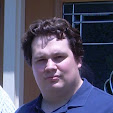Construction, Day one
I chose to work from the side of the instructions that instructs you to build the Forgefield because if push comes to shove I’ll use a Forgefield over a Maulerfiend in my army. The added firepower would be a nice boon for me.The main body sadly uses one of the assembly techniques I truly dislike: Halves. Literally the torso is 2 halves glues together. Though the designers did modify it a bit so it’s largely idiot proof . That’s something of an improvement. The connection points for the sprue are largely in open area so cleaning those spots is easy enough. Though there is one spot that’s right between the spines on the back so you will need a smaller file to clean that particular spot.
 | |
| Some of the filing needs to be done very carefully to avoid damaging detail. |
The kit comes with 2 heads versions. One is the standard “tongue lashing” head, while the other is the gaping maw for the third Ectoplasm cannon option. Of the two, I find the Ecto head to look better, but that’s only by a point of comparison. The tongue head I feel is the poorer of the two because of it’s design. It has this long lashing tongue that is extending out from it’s mouth, yet the mouth isn’t open. So either the fiend just has a giant gaping hole in it’s fangs, or it uses it’s tongue like a snake and whips it out to taste the air. The later idea makes more sense but is more at odds with the over all image and feel of the model, being one that appears to be more monstrous and bovinian… bovinian? Is that even a word?
Anyway, the tongue looks like it was intended to draw reference from the classic Spiderman villain, Venom with the long lashing tongue dripping in drool and toxins. But in all of those images, Venom’s mouth is wide open. With the mouth closed, it just looks weird. Thus I think the Ecto head looks better because the tongue head looks worse. Not because it’s actually better.
 |
| Just because I know someone wants to know. |
One point I do want to point out is building the legs. For a couple reasons these things are a royal pain in the butt. The instructions indicate you should build the back legs as separate sub-units and then attach them to the body. The ankles of the legs even have jointed segments that would suggest the hooves on the back legs are supposed to line up in that particular way. What is the problem with this? Well if you assemble the back legs like this the hooves are facing out from the body, almost like the Fiend is a Lame donkey that’s frankly kicking it’s feet out.
So how do you address this? Simple. Build the legs, but don’t attach the feet to the legs until after you attach the legs to the body. That way you can make sure the feet are flat on the base.
There is another point in the instructions that I would suggest you not follow: The sequence of attaching the back plate and the vents on the back. Despite my absolute best efforts I was totally unable to align the back plate with the mounting stud, on the back, due to the positions of the spine blades so that I was forced to simply put a large glob of glue on the mounting stud and press the plate into the stud. Now this led to another issue, with the vents on the back. The plate was far enough back, but still forward of the mounting stud it’s intended to be mounted on, that it created a minor obstruction with mounting the vents. I was forced to shove the vents on hard. So what am I suggesting? Assemble and install the vents first, then attach the back plate.









0 comments:
Post a Comment